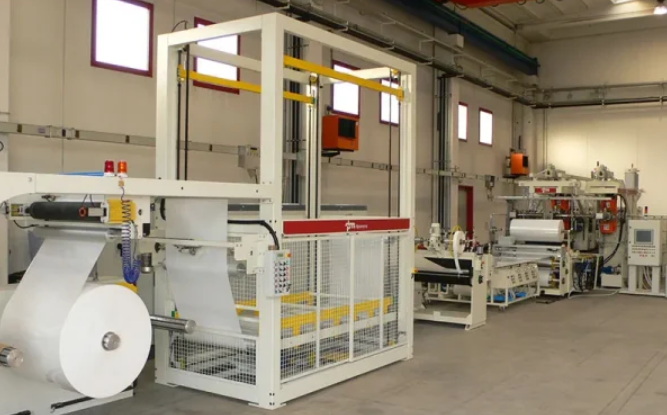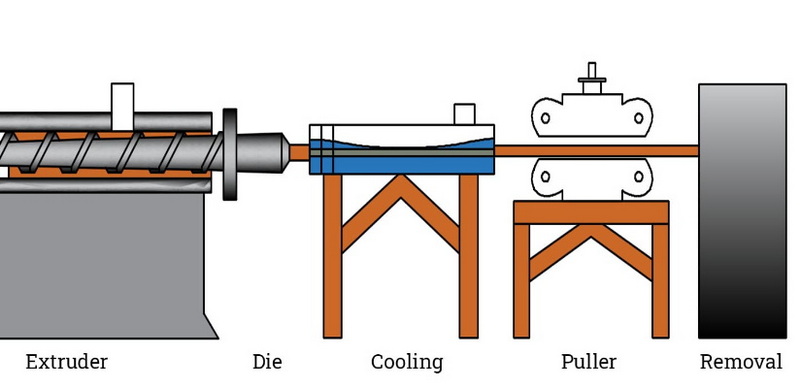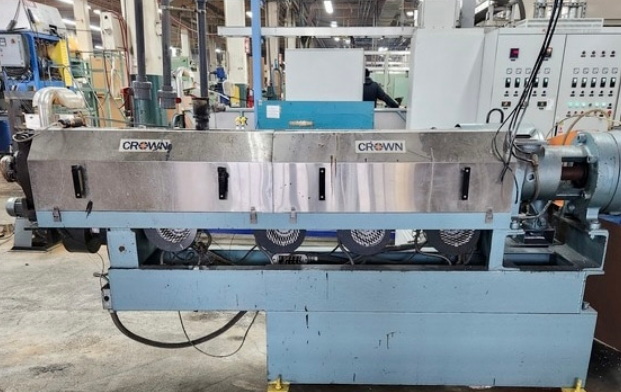Content Menu
● Introduction to Plastic Extrusion
>> Plastic Extrusion Process
● Benefits of Used Plastic Extrusion Equipment
>> 1. Cost Savings
>> 2. Immediate Availability
>> 3. Proven Reliability
>> 4. Environmental Benefits
>> 5. Flexible Financing Options
>> 6. Access to Established Technology
>> 7. Compatibility with Existing Systems
● Challenges in Plastic Extrusion
>> 1. Die Swell
>> 2. Temperature Control
>> 3. Material Degradation
>> 4. Equipment Maintenance
>> 5. Recycling Challenges
>> 6. Tooling Costs
● Evaluating Used Plastic Extrusion Equipment
>> 1. Condition and Age
>> 2. Price and Value
>> 3. Maintenance and Repair Costs
>> 4. Operational Costs
>> 5. Compatibility and Integration
● Market Trends and Future Outlook
● Case Studies
● Best Practices for Purchasing Used Equipment
● Conclusion
● FAQ
>> 1. What are the primary benefits of purchasing used plastic extrusion equipment?
>> 2. How does the cost of used plastic extrusion equipment compare to new equipment?
>> 3. What factors should be considered when evaluating used plastic extrusion equipment?
>> 4. Can used plastic extrusion equipment be easily integrated into existing production lines?
>> 5. How does the environmental impact of purchasing used plastic extrusion equipment compare to buying new?
In the realm of plastic manufacturing, investing in the right equipment is crucial for efficiency, cost-effectiveness, and product quality. One option that has gained popularity among manufacturers is purchasing used plastic extrusion equipment. This decision can be strategic, especially for businesses looking to manage costs while enhancing production capabilities. In this article, we will delve into the advantages and challenges of buying used plastic extrusion equipment, exploring whether it is a smart investment for your business.

Introduction to Plastic Extrusion
Plastic extrusion is a continuous process that transforms thermoplastic feedstock into a molten viscous fluid, which is then shaped and cooled into various forms such as tubes, pipes, profiles, and sheets. This process is widely used due to its efficiency and versatility in producing a wide range of products. The versatility of plastic extrusion allows it to be applied across multiple industries, including construction, automotive, packaging, and consumer goods.
Plastic Extrusion Process
Plastic extrusion involves several key steps:
1. Material Preparation: The raw material, usually in the form of pellets, is fed into the extruder.
2. Melting: The pellets are melted by heat and friction as they move through the barrel.
3. Mixing and Forming: The molten plastic is mixed and formed into the desired shape using a die.
4. Cooling and Solidification: The shaped plastic is cooled and solidified, often using a water bath or air cooling system.
Benefits of Used Plastic Extrusion Equipment
1. Cost Savings
One of the most significant advantages of purchasing used plastic extrusion equipment is the substantial cost savings. These machines are typically priced lower than new ones, allowing businesses to allocate their budget more effectively. This cost-efficiency is particularly beneficial for small to medium-sized enterprises or startups looking to minimize initial capital expenditure.
2. Immediate Availability
Used plastic extrusion equipment is readily available, unlike new machinery that may require weeks or months of lead time. This immediate availability allows businesses to expedite their production processes and respond swiftly to market demands without waiting for extensive manufacturing and delivery timelines.
3. Proven Reliability
Purchasing used plastic extrusion equipment often means investing in models that have a proven track record of performance. The durability and reliability of certain brands and models are tried and tested, giving buyers confidence in the equipment's capabilities.
4. Environmental Benefits
Opting for used plastic extrusion equipment supports circular economy principles by extending the lifecycle of existing machines. This reduces the demand for new machinery manufacturing, which in turn minimizes resource consumption and environmental impact.
5. Flexible Financing Options
Used plastic extrusion equipment often comes with more flexible financing options compared to new machinery. This can include leasing arrangements or more favorable loan terms, making it easier for manufacturers to manage cash flow and investment.
6. Access to Established Technology
Used plastic extrusion equipment often incorporates well-understood and widely used technologies. This familiarity can simplify the training process for operators and maintenance staff, leading to fewer disruptions in production.
7. Compatibility with Existing Systems
Used plastic extrusion equipment can often be more easily integrated into existing production lines and systems compared to new equipment that may require significant changes or upgrades to current processes.

Challenges in Plastic Extrusion
While used plastic extrusion equipment offers several benefits, there are also challenges associated with the plastic extrusion process itself:
1. Die Swell
This occurs when the plastic expands upon exiting the die, potentially altering the intended dimensions of the product. This phenomenon is especially prevalent in rubber and thermoplastic materials. Managing die swell requires precise control over extrusion conditions and die design.
2. Temperature Control
Maintaining a consistent temperature is crucial in plastic extrusion. Variations in temperature can lead to inconsistencies in the product's physical properties, such as strength and transparency. Advanced temperature control systems can help mitigate these issues.
3. Material Degradation
Overheating during the extrusion process can lead to material degradation, negatively impacting the quality of the final product. This can be prevented by optimizing the extrusion process parameters and ensuring proper cooling.
4. Equipment Maintenance
The extrusion equipment is subjected to continuous wear and tear due to the high-speed, high-volume nature of the process. Frequent maintenance is required to ensure optimal performance and prevent breakdowns. Regular checks on components like screws, barrels, and dies are essential.
5. Recycling Challenges
While extrusion allows for material reuse, the quality of the recycled plastic can degrade after multiple extrusion cycles, affecting the final product's properties. This requires careful management of recycling processes and material selection.
6. Tooling Costs
The creation of custom dies and tooling for specialized products can be an expensive upfront cost. This can be a significant barrier, particularly for small-scale manufacturers or for low-volume production runs. However, advances in tooling technology have made it more accessible.
Evaluating Used Plastic Extrusion Equipment
When considering the purchase of used plastic extrusion equipment, several factors should be evaluated:
1. Condition and Age
The condition and age of the equipment are crucial. Older machines may require more maintenance and could be less efficient compared to newer models. It is important to inspect the equipment thoroughly and assess its remaining lifespan.
2. Price and Value
The price should be compared to that of a new machine of similar specifications. Generally, used equipment should cost about one-third of the price of a new one. This comparison helps determine if the purchase is economically viable.
3. Maintenance and Repair Costs
Allow for additional costs to fix any broken parts and for shipment. This can add up to another third of the purchase price. A detailed assessment of potential maintenance needs is essential to avoid unexpected expenses.
4. Operational Costs
Consider the operational costs, including energy consumption and labor. More efficient machines can reduce these costs over time. Evaluating the energy efficiency and production capacity of the equipment is vital.
5. Compatibility and Integration
Ensure that the used plastic extrusion equipment can be easily integrated into existing production lines. This includes compatibility with current tooling, dies, and other machinery.
Market Trends and Future Outlook
The demand for used plastic extrusion equipment is influenced by several market trends:
- Sustainability: The push towards sustainable practices has increased interest in used machinery as a way to reduce waste and support the circular economy.
- Technological Advancements: Advances in technology have made newer equipment more efficient and environmentally friendly. However, this also means older models become more affordable and accessible.
- Global Supply Chains: Disruptions in global supply chains have highlighted the importance of having readily available equipment to maintain production continuity.
Case Studies
Several companies have successfully integrated used plastic extrusion equipment into their operations:
1. Small-Scale Manufacturers: Startups and small businesses have leveraged used equipment to quickly establish production lines without significant upfront costs.
2. Diversification Strategies: Larger companies have used used plastic extrusion equipment to diversify their product offerings or enter new markets without committing to expensive new machinery.
Best Practices for Purchasing Used Equipment
To ensure a successful purchase, follow these best practices:
1. Inspect the Equipment: Conduct a thorough inspection to identify any potential issues or needed repairs.
2. Check Maintenance Records: Review maintenance and repair history to understand the equipment's condition and potential future needs.
3. Test the Equipment: If possible, test the equipment before purchase to ensure it operates as expected.
4. Negotiate the Price: Be prepared to negotiate based on the condition and any needed repairs.
Conclusion
Buying used plastic extrusion equipment can be a smart investment for businesses looking to enhance their production capabilities while managing costs effectively. The benefits include significant cost savings, immediate availability, proven reliability, environmental sustainability, and flexible financing options. However, it is crucial to evaluate the condition, price, and potential maintenance costs of the equipment carefully. By doing so, manufacturers can make informed decisions that align with their long-term production goals and budget constraints.

FAQ
1. What are the primary benefits of purchasing used plastic extrusion equipment?
The primary benefits include cost savings, immediate availability, proven reliability, environmental benefits, and flexible financing options. These advantages make used plastic extrusion equipment an attractive option for businesses seeking to optimize their operations without straining their budgets.
2. How does the cost of used plastic extrusion equipment compare to new equipment?
Generally, used plastic extrusion equipment costs about one-third of the price of new equipment of similar specifications. This significant cost reduction is a major draw for businesses looking to manage their capital expenditures effectively.
3. What factors should be considered when evaluating used plastic extrusion equipment?
Key factors include the condition and age of the equipment, its price relative to new equipment, potential maintenance and repair costs, operational efficiency, and compatibility with existing production systems.
4. Can used plastic extrusion equipment be easily integrated into existing production lines?
Yes, used plastic extrusion equipment can often be more easily integrated into existing production lines compared to new equipment. This is because older machines typically use established technologies that are familiar to operators and maintenance staff.
5. How does the environmental impact of purchasing used plastic extrusion equipment compare to buying new?
Purchasing used plastic extrusion equipment supports sustainability by extending the lifecycle of existing machinery, thereby reducing the demand for new equipment manufacturing and minimizing environmental impact.






















